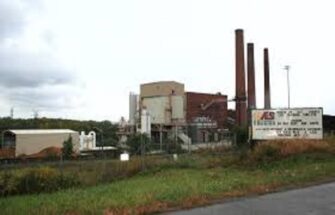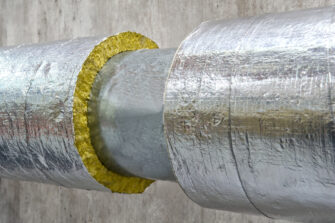Jennison Generating Station
You may be entitled to receive compensation. Mesothelioma and lung cancer victims & their families have been awarded over $1 million+ from easy access to funds. Call us today to apply.
Over the past 20 years, we've helped 1,000s of families claim the compensation they deserve with no upfront costs to them.

The Jennison electric generating station is a former coal-fired power plant in Bainbridge, New York, that operated from 1945 to 2000.
Asbestos-containing materials were widely used at Jennison Station, resulting in many former workers being exposed to the cancer-causing fibers. Those same workers are now at risk for developing mesothelioma, lung cancer and asbestosis.
Numerous asbestos trust funds name Jennison Station as a job site where asbestos was used. If you or a loved one has been diagnosed with an asbestos disease after working at Jennison, you need to learn about your legal right to compensation.
At Belluck Law, our experienced New York mesothelioma lawyers have successfully fought for the rights of Jennison workers who have been diagnosed with life-threatening asbestos diseases. We have in-depth information on when and where asbestos was used at the power station and which companies supplied the materials. To speak with one of our top-rated asbestos lawyers, schedule a free case review now.
Asbestos Exposure at Jennison Station
Table of Contents
Power stations produce electricity using generators. The generators consist of two main units: the boiler and the turbine.
Jennison power station had two generating units. Each unit was powered by two coal-burning boilers. At coal-fired power plants such as Jennison Station, coal is burned to produce heat. The heat turns water — pumped through pipes inside the boiler — into steam. This steam, which reaches temperatures of 1,000 degrees Fahrenheit and pressures of 3,500 pounds per square inch, is piped to the turbine.
The immense pressure of the steam pushes against giant blades on the turbine and turns the turbine shaft. Connected to the turbine shaft is a generator where electricity is produced.
Thermal Insulation
 Thermal insulation is necessary on boilers and turbines, as well as on associated pipes, valves, pumps, compressors, conveyors, heaters and evaporators, to protect workers from high heat. Until the 1970s, asbestos insulation was used for this purpose.
Thermal insulation is necessary on boilers and turbines, as well as on associated pipes, valves, pumps, compressors, conveyors, heaters and evaporators, to protect workers from high heat. Until the 1970s, asbestos insulation was used for this purpose.
Heat caused the asbestos insulation to deteriorate and release airborne asbestos fibers that workers inhaled and ingested when the insulation was disturbed. This occurred when old, damaged insulation was removed and replaced. It also occurred when insulation was moved in order to access equipment for maintenance and repairs.
Gaskets and Packing
Valves, flanges and other generating system components contained asbestos gaskets that workers regularly removed and replaced. Under high heat and pressure, gaskets became baked onto equipment and often had to be scraped and wire brushed off, creating asbestos dust. Asbestos dust was also generated when asbestos packing material used in pumps was removed and replaced.
Learn more about how asbestos exposure occurred in power plants.
Studies have found that asbestos exposure at power plants is not confined to workers who directly handled asbestos-containing materials. Asbestos dust generated by insulation workers, boiler workers, mechanics and others led to “bystander” exposure among workers in other occupations, including office workers, and even household members of power plant workers.
There is no safe level of asbestos exposure. Exposure to asbestos is the only known cause of the deadly and incurable cancer mesothelioma.
Get A Copy Of Our Free Mesothelioma Treatment Guide
Trusts Name Jennison Station as an Asbestos Job Site
Several trusts identify Jennison Station in Bainbridge, N.Y., as a site where asbestos products were used. Former power plant workers diagnosed with an asbestos disease may be eligible to file claims for compensation with these trusts.
When companies began to be flooded with asbestos personal injury lawsuits in the 1970s, many of them eventually declared bankruptcy and reorganized. As part of their bankruptcy reorganization, asbestos companies placed money in trusts to pay future asbestos disease victims. Collectively, these trusts were funded with more than $30 billion.
The following trusts identify Jennison Station as a site where asbestos products were used:
- Babcock & Wilcox: Babcock & Wilcox made industrial boilers that contained asbestos insulating materials. Asbestos lawsuits against B&W began in 1982. The company’s trust is funded with more than $1.85 billion to compensate asbestos victims.
- Armstrong World Industries: Armstrong World Industries manufactured asbestos products that included insulation, cements and flooring tiles. Armstrong began facing asbestos lawsuits in 1970, and in 2000, it filed for bankruptcy. The Armstrong asbestos trust contains more than $2 billion.
- ACandS: ACandS Inc. is an insulation construction company that installed thermal and mechanical insulation. Products installed by ACandS between 1958 and 1974 contained asbestos. ACandS filed for bankruptcy in 2002. Its asbestos trust — created in 2008 — has more than $528 million in funding.
- Combustion Engineering: Combustion Engineering was a Connecticut-based firm that made asbestos-containing boilers used in thousands of land-based locations across the U.S., as well as for hundreds of ships and shipyards. The Combustion Engineering asbestos trust was established in 2005 and is funded with more than $1.4 billion.
If you worked at Jennison Station and have been diagnosed with an asbestos disease, Belluck Law can help you pursue the compensation you deserve. Contact us now to learn about your legal rights and options.
History of Jennison Generating Station
Construction began on Jennison Station in April 1944. The plant — named after Ralph D. Jennison, then-president of the New York State Electric & Gas Corporation (NYSEG) — was dedicated on December 13, 1945. It was one of three plants built by NYSEG in the 1940s that doubled the generating capacity in south central New York.
The station opened with a 30 MW unit, and a second 30 MW unit went online in 1950. By 1966, the plant’s generators were rated at 73,000 kilowatts. Jennison Station was permitted to burn coal, wood, tire-derived fuel and coal tar soils.
Virginia-based AES Corporation purchased Jennison Station and five other New York power plants in 1999. In 2000, AES announced plans to close the plant due to its age and cost. Electricity was last generated there in October 2000.
Our Lawyers Demand Justice for Asbestos Victims
The nationally recognized mesothelioma lawyers at Belluck Law have the knowledge, resources and experience needed to successfully take on the big asbestos companies. We have recovered more than $1 billion for our clients and their families.
If you were diagnosed with mesothelioma, lung cancer or asbestosis, call Belluck Law today to schedule a free consultation.
Sources:
- New York State Department of Environmental Conservation: Permit Review Report, AES Jennison
- The Daily Star: Jennison plant generated electrical power from 1945 to 2000
- British Journal of Industrial Medicine: Asbestos related health hazards among power plant workers
- Babcock & Wilcox Asbestos Trust
- Armstrong World Industries Asbestos Trust
- ACandS Asbestos Trust
- Combustion Engineering Asbestos Trust
Other Asbestos Companies in New York
- Polly O
- Degraff Memorial Hospital
- Albany Steam Station
- Alfred University
- General Motors Chevrolet Buffalo
- Kimberly Clark In Niagara Falls Asbestos Exposure
- American Laundry In Rochester New York
